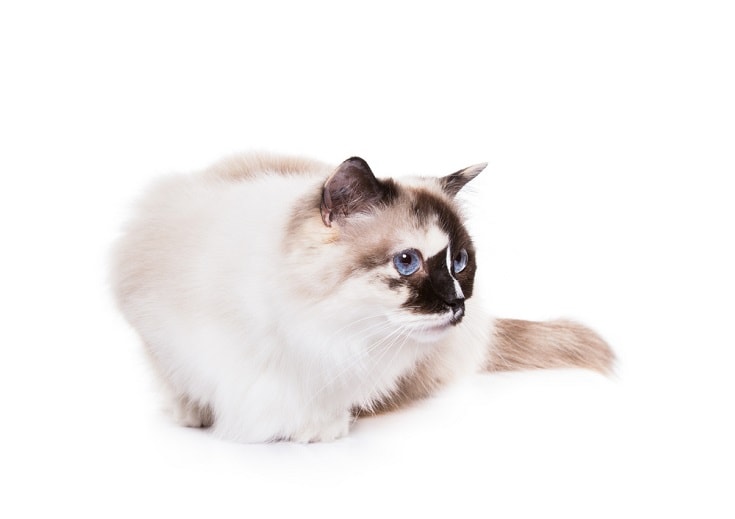
Click to Skip Ahead
Introduction
The Ragdoll cat breed is extremely popular due to their large size and friendly temperament, and a few of the most sought-after ones have a tortoiseshell coat. Keep reading as we explain what the tortoiseshell pattern is and share several other facts to help you determine if this breed is right for you.
Breed Overview
Height:
9–11 inches
Weight:
8–20 pounds
Lifespan:
12–15 years
Colors:
Black, blue, red, white, orange, yellow, grey
Suitable for:
Large families and small families with plenty of time
Temperament:
Calm, loving, playful
Tortoiseshell refers to the pattern that a cat’s coat can have, not the breed. The tortoiseshell pattern creates patches of color all over the body, and the cat’s genes determine the colors. The instruction for color is on the X chromosome. If it calls for eumelanin, the patches will be black, and if it calls for pheomelanin, the patches will be red. Since male cats only have one X chromosome, they cannot produce a true tortoiseshell pattern, as the patches will all be red or black. Female cats have two X chromosomes, so the tortoiseshell pattern will appear if each calls for a different color. Therefore, almost all Ragdoll Tortoiseshell cats are female, with the only exception being the rare male cats born with an extra X chromosome.
Ragdoll Tortoiseshell Breed Characteristics
The Earliest Records of the Tortoiseshell Ragdoll in History
American breeder Ann Baker created the first Ragdoll in the 1960s by combining various domestic cats, including the Persian, Siamese, and Birman. One of these cats had a Siamese color-point coloration. Ragdoll cats have many distinguishable characteristics, including the upside-down V shape on the forehead of bicolor cats, long tails, and large, round, blue eyes. They get their name from their tendency to go limp like a rag doll when picked up.
How the Tortoiseshell Ragdoll Gained Popularity
The Tortoiseshell Ragdoll is a popular cat because of their large size and friendly nature. Often weighing more than 15 pounds, this is one of the largest cats that you can find, and their blue eyes are different from most other breeds. They’re also calm and affectionate and like to cuddle and follow you around the house. They get along well with other pets and enjoy greeting strangers
Formal Recognition of the Tortoiseshell Ragdoll
When Ann Baker created the Ragdoll breed, she didn’t want it recognized by any cat breeding associations. Instead she formed the International Ragdoll Cat Association (IRCA) to maintain the breed in 19711. However, a husband and wife team broke with the IRCA in 1975 and created the Ragdoll standard that the Cat Fanciers Association and other major cat registries could accept2.
Top 8 Unique Facts About the Tortoiseshell Ragdoll
- Ann Baker created the first Ragdoll cats in California, U.S.A.
- The Ragdoll cat breed is one of the few that like water and especially enjoy watching running water.
- Many pet owners describe their Tortoiseshell Ragdoll cat as dog-like because they often wait at the door for them and tend to follow them around the house.
- Ragdoll cats have exceptionally soft fur.
- While most Ragdoll cats have blue eyes, as they age, some cats’ eyes will turn yellow.
- Only about one in 3,000 Tortoiseshell cats is male.
- There are two kinds of Tortoiseshell coats, bridled and patched. A bridled pattern occurs when the colors are intertwined or woven, and the patched pattern will have large clumps of a similar color.
- The tortoiseshell pattern is also available in mosaic and chimera. The mosaic pattern will have black and red colors throughout the body, while the chimera pattern limits each color to one side of the body or face.
Does the Tortoiseshell Ragdoll Make a Good Pet?
Yes, the Tortoiseshell Ragdoll makes a great pet. They’re extremely affectionate and enjoy being around their owners. They will stay relaxed while you carry them around and will sit on your lap while you watch a movie. Their calm temperament and large size make them ideal for pairing with other pets, children, and the elderly. The long fur will need frequent brushing, but that’s usually easy to accomplish because they love being pampered.
Conclusion
The Tortoiseshell Ragdoll is a great choice for any cat lover. The multicolor coat, combined with their large size and big blue eyes, is hard to pass up. These cats are also extremely friendly and enjoy spending time with you, even as you do your daily chores. You can carry them around if you can manage their heavy weight, and their calm nature helps them get along with pets, children, and even strangers.
Featured Image Credit: JFunk






